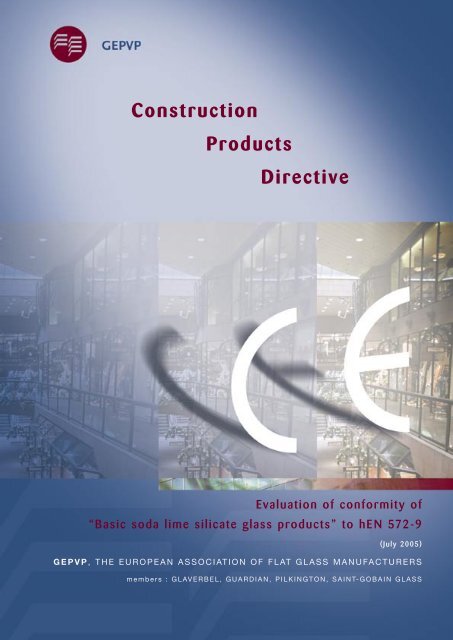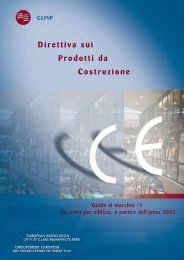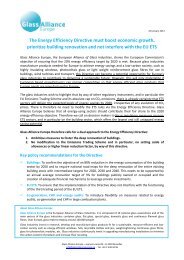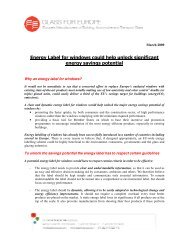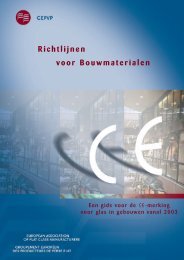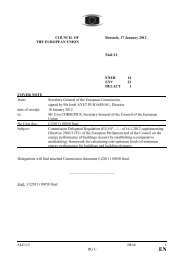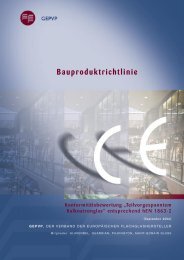GEPVP CPD 3 (EN572-9).EN.indd - Glass for Europe
GEPVP CPD 3 (EN572-9).EN.indd - Glass for Europe
GEPVP CPD 3 (EN572-9).EN.indd - Glass for Europe
You also want an ePaper? Increase the reach of your titles
YUMPU automatically turns print PDFs into web optimized ePapers that Google loves.
Construction<br />
Products<br />
Directive<br />
Evaluation of con<strong>for</strong>mity of<br />
“Basic soda lime silicate glass products” to hE N 572-9<br />
(July 2005)<br />
G E P V P , T H E E U R O P E A N A S S O C I AT I O N O F F L AT G L A S S M A N U FA C T U R E R S<br />
m e m b e r s : G L AV E R B E L , G U A R D I A N , P I L K I N G T O N , S A I N T- G O B A I N G L A S S
Construction Products Directive
Evaluation of con<strong>for</strong>mity of<br />
“Basic soda lime silicate glass products” to hE N 572-9<br />
CONT<strong>EN</strong>TS<br />
A. Background ........................................................................................................................4<br />
B. Audience ...........................................................................................................................4<br />
3<br />
C. Scope ...............................................................................................................................4<br />
D. Methodology ......................................................................................................................4<br />
Annex ZA ..........................................................................................................................4<br />
Attachment 1: h<strong>EN</strong> Clause 4 Requirements .............................................................................11<br />
Attachment 2: h<strong>EN</strong> Clause 5 Evaluation of con<strong>for</strong>mity ..............................................................13<br />
Attachment 3: h<strong>EN</strong> Clause 6 Marking and labelling ..................................................................14<br />
Attachment 4: h<strong>EN</strong> Annex A Factory production control ............................................................14<br />
Attachment 5: h<strong>EN</strong> (Annex B) Provisions <strong>for</strong> voluntary involvement of third party(ies) ...................14<br />
Attachment 6: h<strong>EN</strong> Annex ZA .................................................................................................15
Construction Products Directive<br />
A<br />
BACKGROUND<br />
The first document prepared by <strong>GEPVP</strong> explained the background to compliance with the <strong>CPD</strong> 1 and the second<br />
explained the principles of evaluation of con<strong>for</strong>mity 2 .<br />
This document will explain the system of “Evaluation of Con<strong>for</strong>mity” applicable <strong>for</strong> “basic soda lime silicate glass<br />
products” as laid down in <strong>EN</strong> 572 – 9 3 , the appropriate harmonised <strong>Europe</strong>an Standard (h<strong>EN</strong>).<br />
B<br />
AUDI<strong>EN</strong>CE<br />
This part is applicable to any manufacturer of basic soda lime silicate glass products, i.e. float glass 4 , polished<br />
wired glass 5 , drawn sheet glass 6 , patterned glass 7 , wired patterned glass 8 , wired or unwired channel shaped<br />
glass 9 . It is also applicable to any merchant/supplier of these products, with the exception of wired or unwired<br />
channel shaped glass, in sizes other than those given in Parts 2 to 6, i.e. supplier of supplied or final cut sizes 10 .<br />
C<br />
SCOPE<br />
This is taken from <strong>EN</strong> 572-9.<br />
“This <strong>Europe</strong>an Standard covers the evaluation of con<strong>for</strong>mity and the factory production control of basic soda<br />
lime silicate glass products <strong>for</strong> use in buildings.”<br />
4<br />
D METHODOLOGY (see also summary figure 1)<br />
This document follows the methodology given in the second document. It also follows the same referencing with<br />
respect to “attachments”, etc.<br />
This document includes explanatory in<strong>for</strong>mation on Clause ZA.2.2 – EC Certificate and Declaration of Con<strong>for</strong>mity<br />
(see Attachment 6).<br />
Annex ZA<br />
As detailed in the second document the starting point <strong>for</strong> undertaking the evaluation of con<strong>for</strong>mity is Table ZA.1<br />
(below). This table is colour coded and each essential characteristic is numbered to line up with the corresponding<br />
table in the second document.<br />
The “System of Attestation of Con<strong>for</strong>mity” <strong>for</strong> the claimed intended uses are given in Table ZA.2 of the h<strong>EN</strong>.<br />
Details of the tasks relating to “Assignment of Evaluation of Con<strong>for</strong>mity” are given in Tables ZA.3.1 to ZA.3.3 of<br />
the h<strong>EN</strong> (see second document <strong>for</strong> explanation).<br />
The relationship between the intended use, the applicable “Systems of Attestation of Con<strong>for</strong>mity” and the roles of<br />
the manufacturer and Notified Body(ies) is given in Figure 2. This figure is specific to con<strong>for</strong>mity with <strong>EN</strong> 572-9.<br />
1<br />
<strong>GEPVP</strong> CONSTRUCTION PRODUCTS DIRECTIVE – A guide to CE marking <strong>for</strong> glass in building 2003 onwards<br />
2<br />
<strong>GEPVP</strong> CONSTRUCTION PRODUCTS DIRECTIVE – Evaluation of con<strong>for</strong>mity as laid down in the harmonised <strong>Europe</strong>an<br />
Standards (h<strong>EN</strong>s)<br />
3<br />
<strong>EN</strong> 572 –9 <strong>Glass</strong> in building – Basic soda lime silicate glass products – Part 9: Evaluation of con<strong>for</strong>mity/Product standard<br />
4<br />
<strong>EN</strong> 572 –2 <strong>Glass</strong> in building – Basic soda lime silicate glass products – Part 2: Float glass<br />
5<br />
<strong>EN</strong> 572 –3 <strong>Glass</strong> in building – Basic soda lime silicate glass products – Part 3: Polished wired glass<br />
6<br />
<strong>EN</strong> 572 –4 <strong>Glass</strong> in building – Basic soda lime silicate glass products – Part 4: Drawn sheet glass<br />
7<br />
<strong>EN</strong> 572 –5 <strong>Glass</strong> in building – Basic soda lime silicate glass products – Part 5: Patterned glass<br />
8<br />
<strong>EN</strong> 572 –6 <strong>Glass</strong> in building – Basic soda lime silicate glass products – Part 6: Wired patterned glass<br />
9<br />
<strong>EN</strong> 572 –7 <strong>Glass</strong> in building – Basic soda lime silicate glass products – Part 7: Wired or unwired channel shaped glass<br />
10<br />
<strong>EN</strong> 572 –8 <strong>Glass</strong> in building – Basic soda lime silicate glass products – Part 8: Supplied or final cut sizes
Evaluation of con<strong>for</strong>mity of<br />
“Basic soda lime silicate glass products” to hE N 572-9<br />
Figure 1 – Summary of methodology<br />
Annex ZA<br />
Purchase h<strong>EN</strong><br />
Table ZA.1<br />
1 st column<br />
Table ZA.1<br />
2 nd column<br />
Determine particular<br />
requirements<br />
Define Intended Use<br />
‘essential characteristics’<br />
1 to 13<br />
See Clause 4<br />
Carry out required actions<br />
Table ZA.2<br />
Clause ZA.2.2<br />
Determine System of<br />
Attestation of Con<strong>for</strong>mity<br />
<strong>for</strong> each intended use<br />
Determine assignment<br />
of tasks <strong>for</strong> each system<br />
of attestation<br />
Level 1 Level 3 Level 4<br />
Table ZA.3.1<br />
4 th column<br />
Table ZA.3.2<br />
4 th column<br />
Table ZA.3.3<br />
4 th column<br />
Collect all in<strong>for</strong>mation - Proceed to CE Marking<br />
Prepare Certificate<br />
of Con<strong>for</strong>mity<br />
Level 1 only<br />
Prepare Declaration<br />
of Con<strong>for</strong>mity<br />
Clause ZA.2.3<br />
5<br />
Determine evaluation<br />
of con<strong>for</strong>mity clauses<br />
CE Marking<br />
+<br />
Accompanying<br />
In<strong>for</strong>mation<br />
See Clause 5<br />
and<br />
Annex A
Construction Products Directive<br />
Table ZA1 - Specific to <strong>EN</strong> 572-9: Basic soda lime silicate glass products<br />
Ref<br />
N°<br />
Product: Basic soda lime silicate glass product as covered under the scope of this standard<br />
Intended use: In buildings and construction works<br />
Essential Characteristics<br />
Safety in the case of fire –<br />
Requirements in this<br />
and other <strong>Europe</strong>an<br />
Standard(s)<br />
Mandated<br />
Levels<br />
and/or<br />
classes<br />
Notes<br />
(1)<br />
Resistance to fire (<strong>for</strong> glass <strong>for</strong> use in a glazed<br />
assembly intended specifically <strong>for</strong> fire resistance)<br />
4.1, 4.2.1 and 4.2.2.1<br />
All<br />
Minutes<br />
(2)<br />
(3)<br />
Reaction to fire<br />
External fire per<strong>for</strong>mance (<strong>for</strong> roof coverings only)<br />
4.1, 4.2.1 and 4.2.2.2<br />
4.1, 4.2.1 and 4.2.2.3<br />
Any<br />
Any<br />
Euroclasses<br />
Euroclasses<br />
Safety in Use –<br />
(4)<br />
Bullet resistance: Shatter properties and<br />
resistance to attack<br />
4.1, 4.2.1 and 4.2.2.4<br />
-<br />
Classes of<br />
convenience<br />
6<br />
(5)<br />
Explosion resistance: Impact behaviour and<br />
resistance to attack<br />
4.1, 4.2.1 and 4.2.2.5<br />
-<br />
Classes of<br />
convenience<br />
(6)<br />
Burglar resistance: Shatter properties and<br />
resistance to attack<br />
4.1, 4.2.1 and 4.2.2.6<br />
-<br />
Classes of<br />
convenience<br />
(7)<br />
Pendulum body impact resistance: Shatter<br />
properties (safe breakability) and resistance to<br />
impact<br />
4.1, 4.2.1 and 4.2.2.7<br />
-<br />
Classes of<br />
convenience<br />
(8)<br />
Mechanical resistance: Resistance against<br />
sudden temperature changes and temperature<br />
differentials<br />
4.1, 4.2.1 and 4.2.2.8<br />
-<br />
K and/or °C<br />
(9)<br />
Mechanical resistance: Resistance against wind,<br />
snow, permanent and imposed load and/or<br />
imposed loads of the glass unit<br />
4.1, 4.2.1 and 4.2.2.9<br />
-<br />
mm<br />
(10) Protection against noise:<br />
Direct airborne sound reduction<br />
4.1, 4.2.1 and 4.2.2.10 - dB<br />
Energy conservation and heat retention: –<br />
(11)<br />
Thermal properties<br />
4.1, 4.2.1 and 4.2.2.11<br />
-<br />
W/(m².K)<br />
(12)<br />
Radiation properties:<br />
- light transmittance and reflectance<br />
4.1, 4.2.1 and 4.2.2.12<br />
-<br />
Fractions or %<br />
(13)<br />
- solar energy characteristics<br />
4.1, 4.2.1 and 4.2.2.13<br />
-<br />
Fractions or %
Evaluation of con<strong>for</strong>mity of<br />
“Basic soda lime silicate glass products” to hE N 572-9<br />
Figure 2 - Relationship between Intended Use, System of Attestation of Con<strong>for</strong>mity<br />
and the Roles of Manufacturer and Notified Body – Specific to <strong>EN</strong> 572-9<br />
Ref.<br />
No.<br />
Intended Use<br />
Applicable System<br />
of Attestation of<br />
Con<strong>for</strong>mity<br />
Initial Type Testing<br />
(ITT)<br />
Producer/<br />
Manufacturer<br />
Notified Testing<br />
Body<br />
Producer/<br />
Manufacturer<br />
Factory Production Control (FPC)<br />
Notified Certification Body<br />
Inspection<br />
of FPC<br />
Documentation<br />
Initial Inspection<br />
of Factory<br />
Continuous<br />
Surveillance<br />
of FPC<br />
(1) Fire Resistance<br />
(4) Bullet resistance<br />
1 NA X X X X X<br />
(5) Explosion<br />
Resistance<br />
(3) External Fire<br />
Per<strong>for</strong>mance<br />
(6),(7),<br />
(8),(9)<br />
Safety in Use<br />
(10) Noise Reduction<br />
3 NA X X NA NA NA<br />
7<br />
(11),<br />
(12),<br />
(13)<br />
Energy<br />
Conservation<br />
(2) Reaction to Fire 4 X NA X NA NA NA<br />
Key: NA not applicable<br />
X<br />
body responsible
Construction Products Directive<br />
Figure 3 – Example of a CE Marking label <strong>for</strong> System of Attestation of Con<strong>for</strong>mity - 1<br />
01234 1<br />
AnyCo Ltd, PO Box 21, B-1050<br />
05<br />
01234-<strong>CPD</strong>-00234 2<br />
6mm Polished wired glass<br />
<strong>EN</strong> 572-9<br />
Basic soda lime silicate glass product, intended to be used<br />
in buildings and construction works<br />
8<br />
Characteristics<br />
Resistance to fire E30 3<br />
Reaction to fire A1*<br />
External fire per<strong>for</strong>mance<br />
Bullet resistance<br />
Explosion resistance<br />
Burglar resistance<br />
Pendulum body impact resistance<br />
Resistance against sudden temperature<br />
changes and temperature differentials<br />
Wind, snow, permanent and imposed<br />
load resistance<br />
Direct airborne sound insulation<br />
Thermal properties<br />
NPD<br />
NPD<br />
NPD<br />
NPD<br />
NPD<br />
40K<br />
6mm<br />
31(-2;-3)dB<br />
5,6W/(m 2 .K)<br />
Radiation properties:<br />
Light transmission and reflection 0,85/0,11<br />
Solar energy characteristics 0,83/0,13<br />
1<br />
Identification number of the certification body<br />
2<br />
Certificate number<br />
3<br />
Reference to the certification report. Traceable from the certification report will be detail(s) of the “virtual kit(s)”<br />
used <strong>for</strong> the fire testing.
Evaluation of con<strong>for</strong>mity of<br />
“Basic soda lime silicate glass products” to hE N 572-9<br />
Figure 4 – Example of a CE Marking label <strong>for</strong> System of Attestation of Con<strong>for</strong>mity - 3<br />
AnyCo Ltd, PO Box 21, B-1050<br />
05<br />
6mm Float glass<br />
<strong>EN</strong> 572-9<br />
Basic soda lime silicate glass product, intended to be used<br />
in buildings and construction works<br />
Characteristics<br />
Resistance to fire<br />
NPD<br />
Reaction to fire A1*<br />
External fire per<strong>for</strong>mance<br />
Bullet resistance<br />
Explosion resistance<br />
Burglar resistance<br />
Pendulum body impact resistance<br />
Resistance against sudden temperature<br />
changes and temperature differentials<br />
Wind, snow, permanent and imposed<br />
load resistance<br />
Direct airborne sound insulation<br />
Thermal properties<br />
NPD<br />
NPD<br />
NPD<br />
NPD<br />
NPD<br />
40K<br />
6mm<br />
31(-2;-3)dB<br />
5,6W/(m 2 .K)<br />
9<br />
Radiation properties:<br />
Light transmission and reflection 0,85/0,11<br />
Solar energy characteristics 0,83/0,13
Construction Products Directive<br />
Figure 5 – Example of a CE Marking label <strong>for</strong> System of Attestation of Con<strong>for</strong>mity - 4<br />
AnyCo Ltd, PO Box 21, B-1050<br />
05<br />
4mm Patterned glass<br />
<strong>EN</strong> 572-9<br />
Basic soda lime silicate glass product, intended to be used<br />
in buildings and construction works<br />
Characteristics<br />
10<br />
Resistance to fire<br />
NPD<br />
Reaction to fire A1*<br />
External fire per<strong>for</strong>mance<br />
Bullet resistance<br />
Explosion resistance<br />
Burglar resistance<br />
Pendulum body impact resistance<br />
Resistance against sudden temperature<br />
changes and temperature differentials<br />
Wind, snow, permanent and imposed<br />
load resistance<br />
Direct airborne sound insulation<br />
Thermal properties<br />
NPD<br />
NPD<br />
NPD<br />
NPD<br />
NPD<br />
40K<br />
4mm<br />
29(-2;-3)dB<br />
NPD<br />
Radiation properties:<br />
Light transmission and reflection<br />
Solar energy characteristics<br />
NPD<br />
NPD
Evaluation of con<strong>for</strong>mity of<br />
“Basic soda lime silicate glass products” to hE N 572-9<br />
Attachment 1: h<strong>EN</strong> Clause 4 Requirements<br />
Clause No. Content Explanation<br />
4.1 Con<strong>for</strong>mity with the definition of basic<br />
soda lime silicate glass products<br />
Products shall con<strong>for</strong>m to the definition<br />
and fulfil the requirements of basic soda<br />
lime silicate glass products as defined in<br />
<strong>EN</strong> 572-1.<br />
4.2 Determination of the characteristic’s<br />
per<strong>for</strong>mances<br />
4.2.1 Characteristics of basic soda lime silicate<br />
glass<br />
Basic soda lime silicate glass products are<br />
made in accordance with <strong>EN</strong> 572-1 and one<br />
of the other Parts: <strong>EN</strong> 572-2, <strong>EN</strong> 572-3, <strong>EN</strong><br />
572-4, <strong>EN</strong> 572-5, <strong>EN</strong> 572-6, or <strong>EN</strong> 572-7.<br />
<strong>EN</strong> 572-1: 2004 defines basic glass products in<br />
Clause 3, composition in Clause 5 and physical<br />
and mechanical properties in Clause 6.<br />
The characteristics listed in table 1, concern<br />
general accepted values, calculated values or<br />
measured values.<br />
4.2.2.1 Safety in the case of fire – Resistance to<br />
fire (1)<br />
Fire resistance shall be determined and<br />
classified in accordance with <strong>EN</strong> 13501-2.<br />
4.2.2.2 Safety in the case of fire – Reaction to<br />
fire (2)<br />
Reaction to fire shall be determined and<br />
classified in accordance with <strong>EN</strong> 13501-1.<br />
4.2.2.3 Safety in the case of fire – External fire<br />
behaviour (3)<br />
Where the manufacturer wishes to declare<br />
external fire per<strong>for</strong>mance (e.g. when subject<br />
to regulatory requirements), the product shall<br />
be tested and classified in accordance with<br />
pr<strong>EN</strong> 13501-5.<br />
Note: Compliance with this requirement is not<br />
possible until a version of pr<strong>EN</strong> 13501-5 later than<br />
2002 becomes available.<br />
4.2.2.4 Safety in use – Bullet resistance: Shatter<br />
properties and resistance to attack (4)<br />
Bullet resistance shall be determined and<br />
classified in accordance with <strong>EN</strong> 1063.<br />
The values given in Table 1 can be used without<br />
any further checking.<br />
<strong>Glass</strong> CANNOT be tested <strong>for</strong> resistance to fire<br />
on its own. The tests have to be undertaken in a<br />
glazed assembly.<br />
The glazed assembly being regarded as a<br />
“virtual kit” 1 and is detailed in the official<br />
classification report.<br />
Basic soda lime silicate glass products are<br />
products/materials that do not require to<br />
be tested <strong>for</strong> reaction to fire (e.g. Products/<br />
materials of Classes A1* according to<br />
Commission Decision 96/603/EC, as amended<br />
2000/605/EC).<br />
The present situation is that there are<br />
four different test methods in <strong>EN</strong>V 1187.<br />
The applicability of these tests to glass is not<br />
totally clear. However, be<strong>for</strong>e deciding to test it<br />
is paramount that the manufacturer checks if<br />
this particular glass product type is permitted,<br />
by national regulations, in this application.<br />
Basic soda lime silicate glass products would not<br />
be expected to pass this test method.<br />
NPD is the appropriate in<strong>for</strong>mation <strong>for</strong> the<br />
CE marking label/accompanying in<strong>for</strong>mation.<br />
11<br />
1<br />
Sectorial Group 09 – <strong>Glass</strong> in building: Testing protocol – Safety in case of fire – Fire resistance applicable <strong>for</strong> the CE marking<br />
of glass <strong>for</strong> building.
Construction Products Directive<br />
12<br />
4.2.2.5 Safety in use – Explosion resistance:<br />
Impact behaviour and resistance to<br />
impact (5)<br />
Explosion resistance shall be determined and<br />
classified in accordance with <strong>EN</strong> 13541.<br />
4.2.2.6 Safety in use – Burglar resistance:<br />
Shatter properties and resistance to<br />
attack (6)<br />
Burglar resistance shall be determined and<br />
classified in accordance with <strong>EN</strong> 356.<br />
4.2.2.7 Safety in use – Pendulum body impact<br />
resistance: Shatter properties (safe<br />
breakability) and resistance to impact<br />
(7)<br />
Pendulum body impact resistance shall be<br />
determined and classified in accordance with<br />
<strong>EN</strong> 12600.<br />
4.2.2.8 Safety in use – Mechanical resistance:<br />
Resistance against sudden temperature<br />
changes and temperature differentials<br />
(8)<br />
The resistance against sudden temperature<br />
changes and temperature differentials is<br />
a generally accepted value that is given<br />
in <strong>EN</strong> 572-1 and shall be ensured by<br />
compliance with this standard.<br />
4.2.2.9 Safety in use – Mechanical resistance:<br />
Resistance against wind, snow,<br />
permanent load and/or imposed loads of<br />
the glass unit (9)<br />
The mechanical strength of basic soda lime<br />
silicate glass is a characteristic value that<br />
is given in <strong>EN</strong> 572-1 and is ensured by<br />
compliance with this standard.<br />
As long as on the concerned construction<br />
or building site no part of pr<strong>EN</strong> 13474<br />
is applicable then the current method of<br />
determining mechanical resistance in the<br />
country of destination shall be applied.<br />
The manufactured or supplied thickness of<br />
soda lime silicate glass shall con<strong>for</strong>m to the<br />
ordered thickness.<br />
Basic soda lime silicate glass products would not<br />
be expected to pass this test method.<br />
NPD is the appropriate in<strong>for</strong>mation <strong>for</strong> the<br />
CE marking label/accompanying in<strong>for</strong>mation.<br />
Basic soda lime silicate glass products would not<br />
be expected to pass this test method.<br />
NPD is the appropriate in<strong>for</strong>mation <strong>for</strong> the<br />
CE marking label/accompanying in<strong>for</strong>mation.<br />
Basic soda lime silicate glass products would not<br />
be expected to pass this test method.<br />
The exceptions being special types of polished<br />
wired glass and wired patterned glass.<br />
<strong>EN</strong> 572-1 gives a generally accepted value of<br />
40 K.<br />
Note 1: This value is influenced by edge quality<br />
and glass type.<br />
Note 2: This value may not be the design value<br />
adopted <strong>for</strong> use in, <strong>for</strong> example, thermal stress<br />
calculations.<br />
<strong>EN</strong> 572-1 gives a value <strong>for</strong> the characteristic<br />
bending strength ( f g,k<br />
) of 45 x 10 6 Pa.<br />
Note: The characteristic bending strength has to<br />
be used in conjunction with the design method<br />
given in pr<strong>EN</strong> 13474 1 .<br />
Supplying what was ordered, in terms of<br />
thickness, will cover this characteristic.<br />
1<br />
pr<strong>EN</strong> 13474: This standard is being drafted. It will consist of the following three parts:<br />
- determination by calculation of the resistance to load of glass used in fenestration;<br />
- determination by calculation of the resistance to load of glass used in common non-structural applications other than fenestration;<br />
- general basis of design.
Evaluation of con<strong>for</strong>mity of<br />
“Basic soda lime silicate glass products” to hE N 572-9<br />
4.2.2.10 Protection against noise – Direct airborne<br />
sound reduction (10)<br />
The sound reduction indexes shall be<br />
determined in accordance with <strong>EN</strong> 12758.<br />
4.2.2.11 Energy conservation and heat retention<br />
– Thermal properties (11)<br />
<strong>EN</strong> 12758 gives generally accepted values<br />
that can be used in the absence of measured<br />
data. Hence there is no reason to test this<br />
characteristic.<br />
The thermal transmittance value (U-value)<br />
shall be determined by calculation in<br />
accordance with <strong>EN</strong> 673 with:<br />
• emissivity ε using the value of emissivity as<br />
given in <strong>EN</strong> 572-1<br />
• nominal thickness of the glass panes<br />
4.2.2.12 Energy conservation and heat retention –<br />
Radiation properties: Light transmittance<br />
and reflectance (12)<br />
The light transmittance and reflectance shall<br />
be determined in accordance with <strong>EN</strong> 410.<br />
4.2.2.13 Energy conservation and heat retention<br />
– Radiation properties: Solar energy<br />
characteristics (13)<br />
The solar energy transmittance and<br />
reflectance shall be determined in accordance<br />
with <strong>EN</strong> 410.<br />
<strong>EN</strong> 572-1 gives a value <strong>for</strong> the corrected<br />
emissivity of 0,837.<br />
There<strong>for</strong>e no necessity to have this characteristic<br />
measured.<br />
These values need to be determined in<br />
accordance with the standard <strong>EN</strong> 410.<br />
The manufacturer is responsible <strong>for</strong> ensuring, via<br />
the factory production control (see Tables A1 to<br />
6), that the product continues to have the same<br />
values.<br />
These values need to be determined in<br />
accordance with the standard <strong>EN</strong> 410.<br />
The manufacturer is responsible <strong>for</strong> ensuring, via<br />
the factory production control (see Tables A1 to<br />
6), that the product continues to have the same<br />
values.<br />
13<br />
Attachment 2: h<strong>EN</strong> Clause 5 Evaluation of con<strong>for</strong>mity<br />
5.2.2 Initial type testing if the product belongs<br />
to the group soda lime silicate glass,<br />
clear or tinted<br />
Initial type testing to establish if a product<br />
con<strong>for</strong>ms to the definition of soda lime<br />
silicate glass, shall be economised as much<br />
as possible. For that purpose appropriate<br />
available test reports are equivalent to actual<br />
testing and may be used instead of actual<br />
testing. The initial type testing concerns the<br />
product aspects as listed in table 2.<br />
The chemical composition and determination<br />
of whether or not the glass is clear need to be<br />
determined.<br />
Details of composition, method of determining<br />
whether glass is clear or tinted and acceptance<br />
levels are given in <strong>EN</strong> 572-1.<br />
Any glass called tinted, which could also include<br />
white (also known as low-iron glass), does not<br />
need to be checked to determine if it is clear.<br />
Thickness, including tolerances, is given in<br />
the relevant product standard, i.e. <strong>EN</strong> 572<br />
Part 2 to 7.
Construction Products Directive<br />
Table 2: Product aspects to be checked if product belongs to the group soda lime<br />
silicate glass<br />
Nr Product aspect<br />
1 Chemical composition<br />
2 Thickness<br />
3 Light transmittance (distinction clear glass from tinted glass)<br />
Attachment 3: h<strong>EN</strong> Clause 6 Marking and labelling<br />
6.2 Product marking<br />
There is no requirement to mark basic soda<br />
lime silicate glass products<br />
No requirement <strong>for</strong> marking on these products.<br />
14<br />
Attachment 4: h<strong>EN</strong> Annex A Factory production control<br />
Annex A Factory production control requirements The generalities are covered in the <strong>GEPVP</strong><br />
second document “Evaluation of con<strong>for</strong>mity”<br />
Tables A1<br />
to A6<br />
The Tables A1 to A6 are specific <strong>for</strong> different<br />
product types; i.e. float glass, polished wired<br />
glass, drawn sheet glass, patterned glass,<br />
wired patterned glass, wired and unwired<br />
channel shaped glass.<br />
These cover:<br />
- Incoming raw materials<br />
- Process control<br />
- Product control; both the glass itself<br />
and the specific product<br />
Table A7<br />
Table A7 applies to “supplied and final cut<br />
sizes” of all products except channel shaped<br />
glass, see <strong>EN</strong> 572-8.<br />
The essential characteristics are those that are<br />
supplied with the “stock sizes”. Cutting down<br />
does not modify these characteristics.<br />
However, care should be taken to ensure that<br />
dimensional and quality criteria are met.<br />
Attachment 5: h<strong>EN</strong> Annex B – Provisions <strong>for</strong> voluntary involvement of third party(ies)<br />
See Attachment 5 in the second document. There is nothing specific to this h<strong>EN</strong>.
Evaluation of con<strong>for</strong>mity of<br />
“Basic soda lime silicate glass products” to hE N 572-9<br />
Attachment 6: h<strong>EN</strong> Annex ZA<br />
Clause ZA.2.2 EC Certificate and Declaration of con<strong>for</strong>mity<br />
Depending upon the intended use of the product and hence the applicable “System of Attestation of<br />
Con<strong>for</strong>mity” will be the extent to which this clause applies.<br />
1. Products with System of Attestation of Con<strong>for</strong>mity – 1;<br />
This System of Attestation of Con<strong>for</strong>mity requires the involvement of a Notified Certification Body<br />
(NCB). It is the responsibility of the NCB, when they are satisfied that compliance with the conditions<br />
of the Annex ZA has been achieved, to produce a certificate of con<strong>for</strong>mity (EC Certificate of<br />
Con<strong>for</strong>mity). This certificate allows the manufacturer to affix the CE Marking (see Figure 3). The detail of<br />
what is to be included in the certificate is given in the h<strong>EN</strong>.<br />
When the manufacturer has the certificate of con<strong>for</strong>mity then a declaration of con<strong>for</strong>mity<br />
(EC Declaration of Con<strong>for</strong>mity) has to be produced. The detail of what is to be included in the<br />
declaration is given in the h<strong>EN</strong>.<br />
2. Products with System of Attestation of Con<strong>for</strong>mity – 3;<br />
This System of Attestation of Con<strong>for</strong>mity only requires the involvement of a Notified Body (NB) with the<br />
Initial Type Testing of the product. When the manufacturer is satisfied that compliance with this Annex<br />
has been achieved then a declaration of con<strong>for</strong>mity (EC Declaration of Con<strong>for</strong>mity) is prepared. This<br />
declaration allows the manufacturer to affix the CE Marking (see Figure 4). The detail of what is to be<br />
included in the declaration is given in the h<strong>EN</strong>.<br />
15<br />
3. Products with System of Attestation of Con<strong>for</strong>mity – 4;<br />
This System of Attestation of Con<strong>for</strong>mity does not require the involvement of a Notified Body (NB).<br />
There<strong>for</strong>e when the manufacturer is satisfied that compliance with this Annex has been achieved<br />
then a declaration of con<strong>for</strong>mity (EC Declaration of Con<strong>for</strong>mity) is prepared. This declaration allows<br />
the manufacturer to affix the CE Marking (see Figure 5). The detail of what is to be included in the<br />
declaration is given in the h<strong>EN</strong>.<br />
Duplication of in<strong>for</strong>mation between the certificate, where applicable, and the declaration should be<br />
avoided. This can be done by cross-referencing between documents if one contains more in<strong>for</strong>mation<br />
than the other.<br />
EC Declaration of Con<strong>for</strong>mity and, if applicable, the EC Certificate of Con<strong>for</strong>mity shall be presented in<br />
the official language or languages of the Member State in which the product is to be used.


